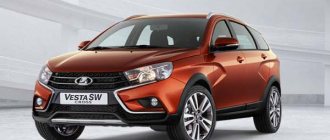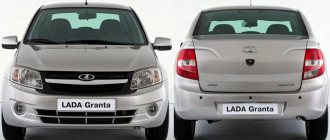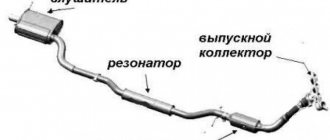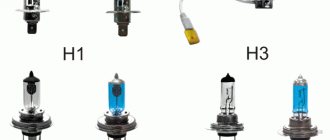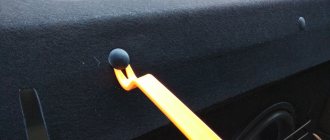When planning to purchase a new car, consumers usually look at descriptions of various models to choose the option that best suits their needs. The trouble is that the average person cannot always understand the specific terminology of the automotive industry.
Even the classification of cars by body type is not clear to everyone, since many still have only the vaguest idea of the differences between a sedan, hatchback and station wagon. Well, let's try to clarify this issue.
Liftback
A liftback is a type of closed car body that is intermediate between a sedan, station wagon and hatchback. It differs from the hatchback in the longer rear overhang: the liftback has the same length as the sedan. The rear part of the roof can be either sloping or (less often) stepped, reminiscent of a sedan.
Body type Liftback
Sedan and its features
In our country, sedans are the most popular - car models with this body type account for about 60% of all cars sold. The main difference between a sedan is the trunk, which in these cars is a closed space separated from the passenger compartment by a solid partition. Because of this, they have a trunk lid in place of the rear door, and the rear window is a solid structure without the ability to lift or slide.
The weight load evenly distributed along both axes makes the sedan as stable and controllable as possible. The body dimensions increased due to the trunk provide a solid exterior, which is important for many buyers. In addition, thanks to the solid wall between the passenger compartment and the trunk, the volume of air in the cabin is relatively small, so it warms up quickly and inexpensively in winter.
Two-volume
The two-volume body does not have a protruding trunk, and its lid opens only with the glass and is considered another door.
Two-volume bodies include hatchbacks, station wagons, as well as crossovers and SUVs created on their basis. Two-volume bodies are distinguished by the most spacious luggage compartments (station wagons) and compact dimensions (hatchbacks - “hatchback”, can be translated in English as “rear door”). At the same time, both station wagons and hatchbacks have a folding rear seat, which allows you to significantly increase the volume of the trunk and the characteristics always indicate its minimum (i.e., with the seats folded down) and maximum (with the seats folded down) values.
Hatchback, station wagon.
Hatchback - a way for the young!
A hatchback (literally “rear hatch”) is a car with a shortened rear overhang, a door, often with two, less often with one row of seats. The main distinguishing feature of the configuration remains the length of the rear part, which is always less than the length of the front. If it is equal to the front, the car cannot formally be classified as a hatchback, even if it has similar shapes.
For example, the Audi 100 in the Avant modification, although the body is externally similar to a hatchback, has a rear overhang length equal to the length of the front one and belongs to the station wagon class. But the Ford Scorpio Mk has a three-volume (classic sedan) body, a pillar in the center to support the roof, but the length of the rear overhang is slightly shorter than the front - the equipment belongs to the Hatchback class.
Advantages of hatchbacks
The main advantage of hatchbacks is considered to be better maneuverability in city traffic due to their smaller size than sedans. What other advantages does the configuration have:
- Lower cost. Hatchbacks are more affordable than sedans and remain mostly budget models.
- The spacious trunk allows you to transport large cargo - if you fold the rear seats, the usable volume increases by 3-4 times.
- Smaller sizes will make parking in the city more convenient.
Hatchbacks are often chosen by young drivers who consider this model to be the most convenient for beginners, despite the fact that hatchback drivers have worse visibility through the rear window than sedan drivers.
Disadvantages of hatchbacks
What disadvantages do this configuration have, and are they so critical for choosing?
- Less comfort for rear row passengers due to the trunk combined with the interior.
- It takes more time to heat the interior in winter and to cool it in summer. Due to this, fuel consumption increases.
- Rear windows require the installation of a windshield wiper and washer.
- Less passive safety when hitting the trunk.
The sedan and hatchback are excellent examples of modern body modification that shouldn't even be a point of contention. You need to choose a model based on the personal preferences of the drivers.
Hatchbacks are an excellent family option; they are good for driving to work and getting out into nature. In addition, there are some models of popular cars that are produced only in a hatchback body - for example, Mercedes-Benz class A, Mazda 2, Fiat Bravo, Grande Punto, VAZ 2191, 1111, etc.
Video about which is better - a sedan or a hatchback:
The development of modern infrastructure has given impetus to the widespread use of various variations of passenger cars for urban traffic and intercity transportation. Hatchbacks and station wagons are especially popular among domestic consumers.
But what is the difference between a hatchback and a station wagon? And what are their advantages over “classic” sedans? In this article we will answer the most common questions from motorists.
A hatchback is a variation of a passenger car with a short overhang, a rear “hatch” door and a small luggage compartment combined with the interior. Depending on the specific configuration, the car may have 1 (less often) or 2 rows of seats, 3 or 5 doors. The luggage compartment can be significantly increased by simply folding the rear seats.
The appearance of hatchbacks was the result of the growing demand for a city car, behind the wheel of which the driver would feel comfortable in dense city traffic during rush hour. The border of the body runs along the edge of the rear wheels. The layout in most cases involves front-wheel drive with a transversely mounted engine. These solutions can significantly increase the vehicle’s maneuverability and make parking possible in difficult conditions.
A beginner who has just graduated from driving school will feel more confident in a hatchback, since the dimensions of the body are much better felt on it.
Let us once again pay attention to the characteristic distinctive features:
- Shortened rear overhang - thanks to this feature, the hatchback can be easily distinguished from other modifications in appearance;
- The trunk volume is less spacious than in station wagons or other variations;
- There is a door in the back wall. In some cases, the glass in it can open separately.
Due to the fact that the interior is actually combined with trunks, passengers may complain about an unpleasant odor emanating from the trunk if specific foods, motor oils, etc. are regularly transported there.
Station wagon: I take everything I own with me!
The station wagon is a five-door passenger car based on a sedan of the same model, in which 4 doors are located on the sides in pairs, and one in the rear of the body. The latter is located vertically and is the lid of the luggage compartment, which communicates with the interior of the car.
If necessary, the luggage compartment volume can be increased by folding the rear row of seats (the same as in the hatchback we discussed above).
Of all types of passenger cars, station wagons are best suited for cargo transportation, which is why they have been consistently popular for many years among people working with large luggage.
The disadvantages of the class, as a rule, include increased injuries among passengers as a result of an accident. In the event of a collision, cargo from the trunk may fly into the cabin. In some countries, traffic regulations require the use of a special dividing grid that protects people from force majeure situations.
Difference between hatchback and station wagon
When choosing a car, a person is guided by many factors, including the cost of the vehicle, the make, model of the car, and, of course, the body type. The last factor is almost decisive, because comfort and the possibility of proper operation of the car directly depend on it. Hatchback and station wagon are widely popular among drivers all over the world, and the difference between the two body types is what determines the motorist’s choice in favor of one option or another.
- Hatchback
- Station wagon
- Comparison
- Conclusions TheDifference.ru
The main differences between a hatchback and a station wagon
Common features inherent in the hatchback and station wagon - both classes are a modified sedan with an essentially combined interior and trunk.
The differences between a hatchback and a station wagon are as follows:
- The size of the luggage compartment is significantly smaller in the Hatchback. The station wagon is excellent for cargo transportation and is often purchased by private entrepreneurs and medium-sized companies precisely for these purposes;
- The hatchback features a more elegant rear design. The inclined door looks much more beautiful than the strict vertical overhang of the station wagon. Women often make choices based on this;
- The station wagon is longer than the hatchback. This can be a significant drawback in urban environments if the car is used only for transporting passengers, but when it comes to large cargo, this is definitely an advantage;
- The hatchback can be supplied in a “sporty” 3-door configuration;
- Station wagons, as a rule, are more expensive than hatchbacks of the same series.
Both classes of passenger cars discussed in this article occupy their niche in the domestic market and are in demand among Russian motorists due to their features.
Station wagon and hatchback are the names of body types of passenger cars. They both have common characteristics, but they also have one fundamentally important difference.
Station wagon
Typically a five-door passenger car with four doors arranged in pairs on the sides and one door at the rear. This door is the luggage compartment lid, and this cargo compartment itself communicates with the vehicle interior. The rear row of passenger seats can be folded, which significantly increases the trunk volume. A station wagon, as a rule, is a variation of the corresponding sedan model, has the same chassis size, drive type, etc. The rear wall-door is closer to vertical in position. A station wagon is the most suitable of all passenger cars for transporting goods, which is why station wagons were (and remain) so popular among gardeners transporting seedlings, building materials, etc. to their country plots.
The VAZ four-station wagon is a typical representative of this class
Kalina with an extended station wagon body
A three- or five-door car with a noticeably shortened rear overhang compared to a station wagon or sedan. Accordingly, the trunk volume of a hatchback is smaller than that of a station wagon. The name hatchback is taken from the English language, where hatch is a hatch, and back is behind. A type of passenger car body with one or two rows of seats, a door in the rear wall and a shortened rear overhang. The shortened rear overhang is the main feature of the hatchback. The appearance of a shortened body, the rear border of which runs almost along the edge of the rear wheels, is caused by the tightness of movement and maneuvering in urban conditions. The layout of all hatchbacks is overwhelmingly the same: front-wheel drive with a transversely mounted engine, which also helps to increase the car’s maneuverability. The luggage compartment of the hatchback is combined with the passenger compartment and also allows you to increase its volume due to the folding rear row seats.
Kalina hatchback main modification
Quick to remember
Station wagon
A passenger car based on a sedan of the same model with a rear door and a luggage compartment combined with the interior.
A passenger car with a rear door, a luggage compartment combined with the interior and a shortened rear overhang. It is shorter in length than a station wagon of the same class, has a smaller trunk volume, but greater maneuverability.
Let your friends know about it too:
Similar materials
An article about sedans and hatchbacks - which car body to choose: advantages and disadvantages, selection criteria. At the end of the article there is a video about which is better - a sedan or a hatchback.
Contents of the article: The answer to this question will be the following question - “Who are you interested in?”, because the debate between domestic drivers about which is better, a sedan or a hatchback, began from the moment the first configuration of the VAZ 2108 hit the roads.
In the CIS countries, of course, sedans are in the lead - it is for these countries that many foreign manufacturers create new modifications in exactly this body style, which are practically not bought in Europe and the USA.
But hatchbacks are confidently conquering the market and taking away a significant piece of the pie from the classic configuration. Sales of sedans in the Russian Federation are in first place - this is approximately 32% of the entire market, hatchbacks have up to 25%, slightly inferior to SUVs.
Experts predict that the compact version of city hatchbacks could become the best-selling car in five years.
New drivers really struggle with which car to choose. Let's consider the main differences between body structures, their advantages and possible disadvantages.
A sedan is comfortable, practical and stylish. The external shape of the body and the interesting design of the radiator grilles make the car presentable and expensive. This is the version in which all premium-segment cars are produced. The traditional sedan body consists of three distinct volumes: the interior, the luggage compartment and the hood volume. The trunk is always isolated from the passenger compartment.
The main feature of the 21st century sedan remains the presence of a central pillar (which is absent in the coupe body) and the size ratio. The length of the luggage compartment should be approximately equal to the length of the engine compartment. It is the length of the body that determines whether a car belongs to a certain class.
The sedan is equipped with one or two (less often three) rows of seats; there is no lifting door in the trunk.
In addition to the classic layout, the sedan category includes the following body types:
- Hardtop. A distinctive feature is the absence of central pillars, side windows without external frames.
- Fastback. A car with a sloping roof and a vaguely defined third luggage compartment.
- Tudor. Two-door sedan. The Chevrolet Monte Carlo can be considered the most prominent representative of the two-door sedan family.
- Long sedan. Today this is a very rare configuration - the car interior has three rows of full-size seats.
A transitional model, which is placed as an intermediate between a sedan and a hatchback, is a liftback. In terms of body shape, the car has overhangs similar to those of a hatchback, but the length of the luggage compartment is the same as in the sedan configuration.
Advantages of sedans
In addition to their representative appearance, sedans have a number of advantages that experienced drivers value so much:
- The sedan provides better weight distribution. This means that at highway speeds the car has ideal stability - it is easier to control and maneuver. The front and rear axles experience almost equal load due to the same volume of the engine and luggage compartment.
- Large and comfortable salon. Adult rear seat passengers notice this clearly.
- The interior is completely isolated from the trunk - this ensures silence and the absence of foreign odors.
- Greater parameter of passive safety of passengers. In the event of an accident, the trunk serves as a buffer.
- In winter, the sedan's interior warms up faster and cools faster in summer - this leads to fuel savings.
But are there any disadvantages to a sedan body style, and is it always beneficial to buy a traditional and familiar model?
Disadvantages of a sedan
- 70% of produced sedans have an average ground clearance of about 155 mm. This clearance will not allow the car to move on relatively easy off-road conditions. Leaving a snowy parking lot is often a problem for sedans. There are always exceptions - the first generation Skoda Octavia has a ground clearance of 170 mm.
- It is more difficult for novice drivers to park in sedans. Large cars require, albeit small, driving experience. Given the city's crowded parking lots and roads, it is more difficult for drivers to find a place to park.
- The cost of a sedan package is 10-15% higher than a hatchback of the same model.
- The rather large trunk volume of a sedan will not allow you to transport long loads (panels, baseboards, refrigerator, etc.).
But all these shortcomings are not perceived by connoisseurs of sedans as a big disadvantage of the configuration.
Many drivers over forty have a love for this car almost at the genetic level. A hatchback (literally “rear hatch”) is a car with a shortened rear overhang, a door, often with two, less often with one row of seats. The main distinguishing feature of the configuration remains the length of the rear part, which is always less than the length of the front. If it is equal to the front, the car cannot formally be classified as a hatchback, even if it has similar shapes. For example, the Audi 100 in the Avant modification, although the body is externally similar to a hatchback, has a rear overhang length equal to the length of the front one and belongs to the station wagon class. But the Ford Scorpio Mk has a three-volume (classic sedan) body, a pillar in the center to support the roof, but the length of the rear overhang is slightly shorter than the front - the equipment belongs to the Hatchback class.
Advantages of hatchbacks
The main advantage of hatchbacks is considered to be better maneuverability in city traffic due to their smaller size than sedans. What other advantages does the configuration have:
- Lower cost. Hatchbacks are more affordable than sedans and remain mostly budget models.
- The spacious trunk allows you to transport large cargo - if you fold the rear seats, the usable volume increases by 3-4 times.
- Smaller sizes will make parking in the city more convenient.
Hatchbacks are often chosen by young drivers who consider this model to be the most convenient for beginners, despite the fact that hatchback drivers have worse visibility through the rear window than sedan drivers.
Sedan or crossover: what to choose Reviews
Young motorists often choose a larger car to assert themselves. A crossover is ideal for this: for a small overpayment relative to a sedan, you get a “jeep,” which has been considered prestigious by default in Russia since the 1990s. But an ordinary car can be no less status. It’s not for nothing that Bentley, Rolls-Royce and Jaguar have always made exclusively sedans, and the first all-terrain vehicles appeared in the model range of these brands quite recently - for the sake of fashion. Of course, these are examples from the highest price category, but Creta, compared to Solaris, is by no means a premium option.
Yesterday's driving school graduates are better suited to a regular passenger car than a crossover. The latter is larger in size, heavier, and has a higher center of gravity. As a result, not yet knowing all the nuances of driving a car, a novice motorist dooms himself to communicate with more complex equipment. The all-terrain vehicle rolls more when driving, it has worse visibility, and is more prone to rollover. In addition, plug-in all-wheel drive can instantly change the behavior of the car, for which a beginner will not be ready. It's not far from the accident here. Conclusion: the crossover driver should be more careful when cornering.
By the way, about accidents. SUVs have a feature that is completely absent in sedans: upon impact, things from the rear parcel shelf and even from the trunk may well fly into the heads of the driver and passengers. True, owners of hatchbacks and station wagons should be wary of the same thing, but in Russia they play secondary roles, and the main struggle is between crossovers and sedans.
Well, while the cargo is in its place, all the smells go into the cabin. Whether it's a can of gasoline or food for outdoor recreation, you'll have to sniff the contents of the luggage compartment the whole way. On the other hand, you can always reach out, for example, to a fragrant sausage and have a snack right on the road. And the owner of the crossover must not forget to constantly close the curtain over the trunk. Otherwise, all its contents will be visible to strangers, which can lead to unpleasant consequences in the form of broken glass and lack of personal belongings.
Putting something heavy in the trunk of an SUV is a more difficult task than in the case of a sedan. The latter have a smaller loading height, so it’s easier to load anything there. On the other hand, a washing machine, for example, simply won’t fit there. And in a crossover - easily!
The hope for increased ground clearance compared to a sedan may also not come true. And it happens that the ground clearance is even lower than that of a passenger car! So the drivers of both cars are equally at risk of hitting their bottoms in a deep rut. For example, there are several “all-terrain vehicles” with a clearance of 165-170 millimeters. For comparison: a regular Lada Vesta sedan has 178 millimeters under the crankcase protection. Well, who is the crossover here?
At the same time, most owners do not fully realize all the capabilities of a tall car. All-wheel drive may be useful only in winter, but such cars are not very suitable for serious off-road conditions. And it’s also easy to scratch on some branch! In addition, most drivers simply do not know how to drive off asphalt, as a result of which they land the crossover in the first puddle. And this is not to mention the fact that a rare driver understands the operation of the all-wheel drive system or transmission; they do not know what a reduction gear is and how to use it. Often, it is incorrect operation that disables various units, and the car enthusiast who killed them blames the quality of modern technology.
When buying a crossover, you can forget about saving. Firstly, an all-terrain vehicle will cost more than a sedan of a similar class. In the case of an all-wheel drive car, an additional payment is for the transmission, but buyers of single-wheel drive cars also overpay for the image.
Secondly, ongoing maintenance will also be more expensive. Even for a front-wheel drive SUV, not to mention a more complex all-wheel drive.
Liberals
The two-volume body does not have a protruding trunk, and its lid opens only with the glass and is considered another door.
Two-volume bodies include hatchbacks, station wagons, as well as crossovers and SUVs created on their basis. Two-volume bodies are distinguished by the most spacious luggage compartments (station wagons) and compact dimensions (hatchbacks).
Hatchback, station wagon
The number of cars on our roads is constantly growing. Manufacturers, trying to please all customers, improve not only the “filling”, interior, design of the car, but also the body. For our comfort, they try to combine several designs in one body type, which results in more varieties, and they are so similar to each other. But you can distinguish them, and we will help you figure it out.
The most common body types in our area are sedan, hatchback, station wagon, crossover, and SUV. Coupe, minivan, compact van, pickup truck are less common.
Sedan
The sedan is the most popular body type among passenger cars in our country. This is a three-volume body with four doors and a separate luggage compartment. Average ground clearance will allow you to travel both around the city and on the highway. The disadvantage is the small trunk, which is quite limited in height. The price of sedans varies greatly. From a huge selection you can choose a sedan of both B class and E class, it all depends on your preferences and financial capabilities.
Examples of sedan cars
The coupe is also a three-volume body; the main difference from the sedan is the number of doors: the coupe has two. The design is more understated, sporty, and therefore more powerful. Because there are only two, they are slightly larger than the sedan, which adds to the comfortable driving position. Among the minuses, in addition to the insufficient luggage compartment, we can note the inconvenient entry of second-row passengers. This type of body is suitable for travel by one passenger, and there are no plans to transport large items. Examples of cars with coupe body type
Hatchback 3 and 5 doors
A hatchback is a two-volume body type that differs from a sedan in the volume of the trunk: it is smaller, but the rear door starts from the roof, which will allow you to transport tall objects, and the folding second row of seats will increase the luggage space. Suitable for purchase by novice drivers as a first car, because this body type is small-sized, very maneuverable, and ideal for the urban jungle. The main drawback is the low power, and in the three-door versions there is an uncomfortable seating position for passengers in the second row of seats.
Examples of passenger cars with a hatchback body type
A type of hatchback is a liftback. This body type has a distinctive feature in the form of a small step on the fifth door (liftback - “lifting lid”). The trunk is connected to the rear window and opens with it. But in appearance, the liftback resembles a sedan and is often confused with it due to the protrusion on the luggage compartment lid. Station wagon
A station wagon is a two-volume type of passenger car body that has an increased luggage compartment compared to a sedan. The passenger compartment and luggage compartment are connected, and the roof extends to the rear door. This is an advantage for choosing a family car: all family members can comfortably fit in the cabin, and all the cargo will fit in the luggage compartment.
Example station wagon body type
You can clearly understand the differences between a hatchback, sedan and station wagon using the example of a car. The picture clearly shows the difference between body types from one to another.
Crossover
Crossover is a two-volume body type. This is something between an SUV and a station wagon, or less often a hatchback, combining the disadvantages and advantages of these different classes. The crossover differs from a hatchback in its higher ground clearance and, accordingly, increased cross-country ability, but does not reach the level of jeeps due to lower power and sometimes the presence of single-wheel drive. The crossover is a fairly popular car on our roads. It has the confidence of an SUV, the efficiency of a station wagon and the comfort of both driver and passengers, regardless of whether you are carrying luggage or not. To meet customer demand, manufacturers began to produce simplified all-wheel drive systems and produce one-wheel drive crossover models. They are used only in urban conditions, and off-road capability is practically no better than that of station wagons, which is why the expression “parquet SUV” or “SUV” for short began to appear among the people. Now this term is often used for all models with a crossover body type, without taking into account the actual cross-country ability parameters.
Examples of cars with crossover body type
SUV or Jeep
An SUV is also a two-volume body type, and as stated just above, it is a car with a high degree of cross-country ability. How to distinguish an SUV externally from another type of car body? An SUV is an all-wheel drive vehicle with a frame body, high ground clearance (more than 200 mm), and large wheels. Since this car was created for off-road travel, it is distinguished by high power and, accordingly, high fuel consumption. Therefore, among the disadvantages we can note: high cost (both purchase and costs for spare parts, refueling). This type of body is perfect for lovers of extreme types of recreation, solving the complex problems of Russian off-road, or can take a snowmobile, ATV, or jet ski with them, and for city residents, an SUV will be a prestigious and reliable car, but it will not be able to reveal its full potential.
Examples of SUVs
Pickup
There are also SUVs with a closed driver's cabin and a large open luggage compartment. This body type is called a pickup truck. A pickup truck is a two- or four-door all-wheel drive (rarely rear-wheel drive) SUV with 1 or 2 rows of seats arranged in a 2, 2+1, 2+2, 2+3 pattern, which looks like a small truck. The main advantage of this car is the luggage compartment, which is unlimited in height. The cargo bed has a tailgate and can be installed with a soft top (with a hard top installed, the pickup turns into a van). A pickup truck is purchased by people whose line of work involves small-scale cargo transportation, as well as by people living outside the city, because transporting a dozen bags of crops on a pickup truck is a pleasure.
Some models with a pickup body type
There are also single-volume body types. These include buses of various sizes: minivan (mandatory presence of a third row of seats, sliding side doors, length of at least 4.5 m), compact van (smaller version of the minivan - length 4.2-4.5 m) and microvan (enlarged copy of the station wagon , length up to 4.2 m).
No, it’s not that the coupe is a two-seater car, and, of course, it’s not that the coupe has only two doors, and the sedan has four. Neither the headlights, nor the turn signals, nor the foglights, nor the grilles, nor much else is the real difference between a sedan and a coupe. Everything is much simpler.
Many car enthusiasts have difficulty determining the body type, especially when determining whether it is a sedan or a coupe. It is traditionally believed that a coupe has only two doors, and a sedan has four. But in reality there are both four-door coupes and two-door sedans, so the differences between them may not be so obvious.
The difference between these two body types is not the number of doors or the shape of the body, but the amount of interior space.
There are certain standards according to which a coupe is a car with rear seat space of less than 0.93 cubic meters. Accordingly, a sedan is a car with rear passenger space equal to or greater than 0.94 cubic meters. Therefore, two-door cars with a rear seat volume of more than 0.94 cubic meters are two-door sedans, but they are often sold as coupes. This is done in order to focus on the sportiness of the car and, for the most part, does not indicate the technical features and characteristics of the car, but the place it occupies in the market and the set of qualities that consumers need. This is a common marketing ploy that sellers use to attract the attention of buyers. This causes confusion among owners of such cars.
In fact, when deciding to buy a car, the most important thing is to pay attention to what it is called. Comfort, technical characteristics, and basic functions play a big role. For some, the determining factor may be appearance, and for others, price.
The introduction of the body as a load-bearing part of a passenger car made it possible to significantly expand the number of body types. But among all the variety of body types, there are the most popular among car enthusiasts. The leader among the types of load-bearing part is the sedan, but lately the hatchback body has been a good competitor to it. Each of them has its own differences, as well as positive and negative sides. Let's try to figure out what the features of sedan and hatchback bodies are, as well as what their advantages and disadvantages are.
Classic of the genre - sedan
A sedan is comfortable, practical and stylish. The external shape of the body and the interesting design of the radiator grilles make the car presentable and expensive. This is the version in which all premium-segment cars are produced. The traditional sedan body consists of three distinct volumes: the interior, the luggage compartment and the hood volume. The trunk is always isolated from the passenger compartment.
The sedan is equipped with one or two (less often three) rows of seats; there is no lifting door in the trunk.
- Hardtop. A distinctive feature is the absence of central pillars, side windows without external frames.
- Fastback. A car with a sloping roof and a vaguely defined third luggage compartment.
- Tudor. Two-door sedan. The Chevrolet Monte Carlo can be considered the most prominent representative of the two-door sedan family.
- Long sedan. Today this is a very rare configuration - the car interior has three rows of full-size seats.
A transitional model, which is placed as an intermediate between a sedan and a hatchback, is a liftback. In terms of body shape, the car has overhangs similar to those of a hatchback, but the length of the luggage compartment is the same as in the sedan configuration.
Advantages of sedans
In addition to their representative appearance, sedans have a number of advantages that experienced drivers value so much:
- The sedan provides better weight distribution. This means that at highway speeds the car has ideal stability - it is easier to control and maneuver. The front and rear axles experience almost equal load due to the same volume of the engine and luggage compartment.
- Large and comfortable salon. Adult rear seat passengers notice this clearly.
- The interior is completely isolated from the trunk - this ensures silence and the absence of foreign odors.
- Greater parameter of passive safety of passengers. In the event of an accident, the trunk serves as a buffer.
- In winter, the sedan's interior warms up faster and cools faster in summer - this leads to fuel savings.
But are there any disadvantages to a sedan body style, and is it always beneficial to buy a traditional and familiar model?
Disadvantages of a sedan
- 70% of produced sedans have an average ground clearance of about 155 mm. This clearance will not allow the car to move on relatively easy off-road conditions. Leaving a snowy parking lot is often a problem for sedans. There are always exceptions - the first generation Skoda Octavia has a ground clearance of 170 mm.
- It is more difficult for novice drivers to park in sedans. Large cars require, albeit small, driving experience. Given the city's crowded parking lots and roads, it is more difficult for drivers to find a place to park.
- The cost of a sedan package is 10-15% higher than a hatchback of the same model.
- The rather large trunk volume of a sedan will not allow you to transport long loads (panels, baseboards, refrigerator, etc.).
But all these shortcomings are not perceived by connoisseurs of sedans as a big disadvantage of the configuration. Many drivers over forty have a love for this car almost at the genetic level.
